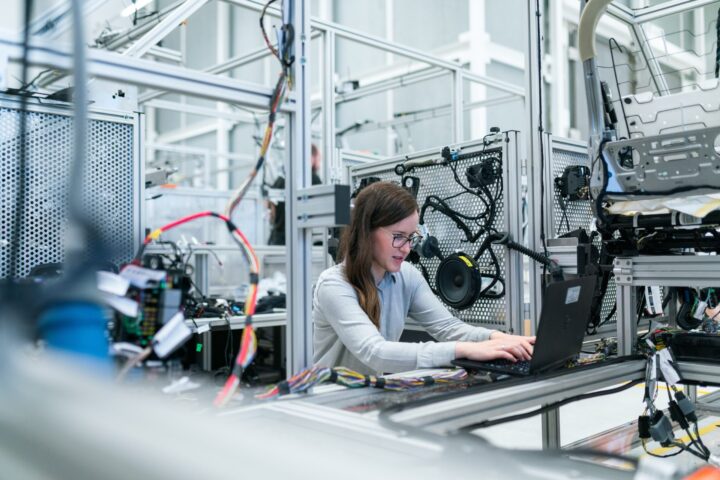Artificial intelligence (AI) in education refers to the application of AI technology to strengthen and advance the educational system. It includes a wide range of software and equipment made to tailor instruction, speed up office work, and give statistical knowledge into student performance. AI in education has the potential to completely change how we teach and learn, benefiting both teachers and students in a variety of ways.
AI can alter the educational system by personalizing learning, for example. Using AI, individualized learning programs can be developed for each student based on their unique requirements and interests. Students may be able to learn at their own rate and realize their full potential as a result. A personalized learning platform like Knewton, for instance, uses AI to develop unique learning strategies for each student. AI is used by Carnegie Learning to give students immediate feedback on their assignments. Duolingo is a language learning platform that uses AI to track students’ progress and provide personalized instruction. Real-time feedback is another way AI can alter the educational system. AI can be used to give students immediate feedback on their work, assisting them in finding and fixing mistakes.
Students’ comprehension and memory of the content may increase because of this. For instance, Sofia, a virtual instructor driven by AI, can give students individualized training. Sofia can give students advice on their work, respond to their inquiries, and even assist them in making study schedules can also be used to automate tasks such as grading, data analysis, and scheduling. This can free up teachers’ time so they can focus on more important tasks, such as providing instruction and guidance. For example, the AI-powered chatbot, Lara, can answer students’ questions and provide support. Lara can also help teachers to manage their classrooms and track student progress.
In addition to these advantages, AI offers the ability to improve accessibility for students who live in rural areas or have disabilities. For instance, everyone around the globe can use Khan Academy, an AI-powered learning platform. Videos, exercises, and quizzes are among the tools and courses that Khan Academy provides.

How AI Can Change the Education System:
AI can change the education system in several ways:
- Personalized Learning: AI algorithms can analyze students’ learning patterns and adapt educational content to their individual needs, ensuring that each student learns at their own pace and style.
- Adaptive Learning Platforms: AI-driven platforms can adjust the difficulty of coursework in real time, keeping students engaged and challenged without overwhelming them.
- Efficient Administrative Tasks: AI can automate administrative tasks like attendance tracking, grading, and scheduling, allowing educators to focus more on teaching.
- Virtual Assistants and Tutors: AI-powered virtual assistants can provide instant answers to students’ questions and offer tutoring outside of regular class hours.
- Data-Driven Insights: AI can analyze educational data to identify trends, learning patterns, and areas of improvement, helping educators make informed decisions.
- Language Learning and Translation: AI can facilitate language learning by offering real-time translation, making it easier for students to learn and communicate globally.
- Accessibility and Inclusion: AI-driven assistive technologies ensure that students with disabilities have equal access to educational resources.
- Automated Content Creation: AI can generate educational content, including quizzes and textbooks, saving educators time, and ensuring up-to-date materials.
- Identifying Learning Gaps: AI can identify when students are struggling with specific concepts and provide targeted interventions to address these gaps.
- Teacher Professional Development: AI can analyze teaching methods and suggest improvements based on student outcomes, fostering ongoing professional development for educators.
- Simulations and Experiential Learning: AI-powered simulations create immersive learning experiences, allowing students to experiment and learn in a risk-free virtual environment.
- Predictive Analytics: AI can predict at-risk students and provide early interventions to improve retention rates.
- Global Collaboration: AI facilitates global collaboration among students and educators, connecting classrooms from different parts of the world for cultural exchange and joint projects.
- Continuous Learning: AI supports lifelong learning by offering personalized courses and resources throughout individuals’ lives, enabling them to acquire new skills and stay updated.

Educational Platforms Already Using AI:
- Duolingo: Duolingo employs AI to craft personalized language learning paths, adapting content and challenges to suit each learner’s proficiency and pace.
- Khan Academy: By leveraging AI, Khan Academy tailors educational content and exercises to individual student needs, fostering a deeper understanding of various subjects.
- Coursera and edX: These platforms integrate AI to automate assessment and grading processes, providing learners with timely feedback, and allowing instructors to focus on instructional aspects.
- DreamBox: DreamBox harnesses AI to create an adaptive math program that adapts difficulty levels based on student’s progress, encouraging critical thinking and problem-solving skills.
- Carnegie Learning: Through AI-guided recommendations, Carnegie Learning assists students in navigating math problems, offering hints and strategies to enhance comprehension.
- ScribeSense: ScribeSense utilizes AI to convert handwritten notes into digital text, promoting efficient note-taking and organization for students.
- Smart Sparrow: Smart Sparrow’s AI-driven platform empowers educators to design interactive lessons that adapt in real time based on students’ responses, fostering active and engaging learning experiences.
- Squirrel AI: Squirrel AI employs AI tutors to offer personalized guidance to students in various subjects, providing tailored explanations and support to improve learning outcomes.
- Cognii: Cognii’s AI-powered virtual tutor provides immediate feedback on written assignments, guiding students in refining their writing skills and enhancing their communication abilities.
- Pearson’s Aida: Pearson’s Aida integrates AI to assist instructors in efficiently grading assignments, allowing educators to focus on valuable classroom interactions and teaching strategies.
Benefits of Using AI in Education:
- Personalized learning experiences
- Improved student engagement and retention
- Timesaving through automation of administrative tasks
- Enhanced accessibility and inclusivity
- Data-driven insights for informed decision-making
- Global collaboration opportunities
- More effective teacher professional development
- Predictive analytics to identify at-risk students.
Implementing AI in Education:
To implement AI in the education system, organizations can follow these steps:
- Assessment: Identify the specific needs and goals for implementing AI in education.
- Data Collection: Gather relevant educational data, including student performance, curriculum materials, and administrative data.
- AI Selection: Choose AI tools or platforms that align with the educational objectives.
- Integration: Integrate AI solutions into existing educational systems and workflows.
- Teacher Training: Provide training to educators to effectively use AI tools.
- Monitoring and Evaluation: Continuously monitor AI implementation and evaluate its impact on learning outcomes.
- Feedback and Iteration: Gather feedback from educators, students, and stakeholders and make necessary adjustments.

The Future of Education with AI:
The future of education with AI holds exciting possibilities. AI will continue to evolve and play an increasingly prominent role in the education system. We can anticipate:
- Even more personalized learning experiences.
- Enhanced virtual and augmented reality for immersive learning.
- Advanced AI-powered assessments and feedback.
- Greater global collaboration and cultural exchange.
- Increased use of AI for teacher professional development.
- Expanded lifelong learning opportunities.
- Ethical and privacy considerations as AI becomes more integrated.
In conclusion, educational AI has the potential to revolutionize education by personalizing learning, streamlining administrative tasks, and providing data-driven insights. Numerous platforms already use AI to improve learning outcomes, and as AI continues to advance, the future of education will be characterized by greater customization, accessibility, and innovation.
